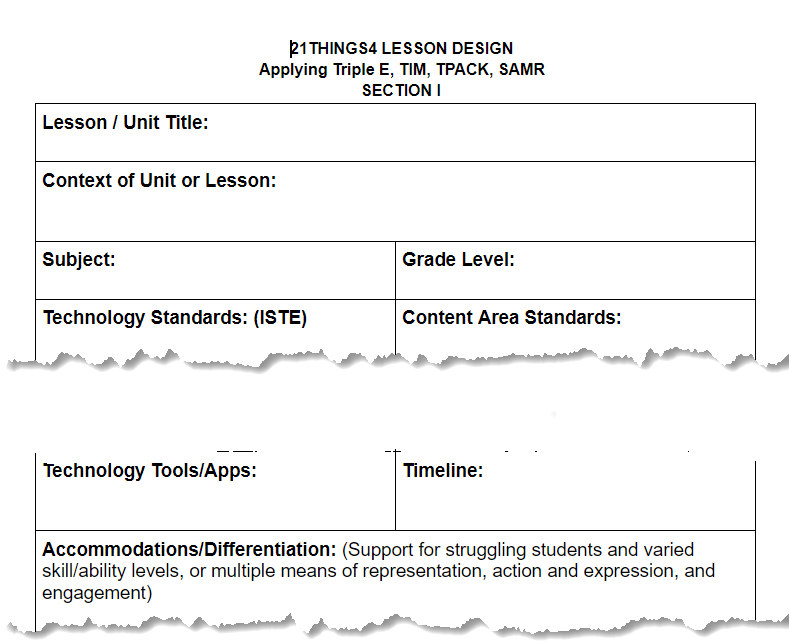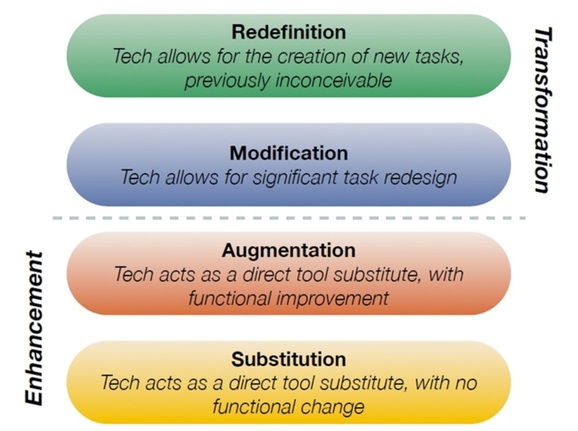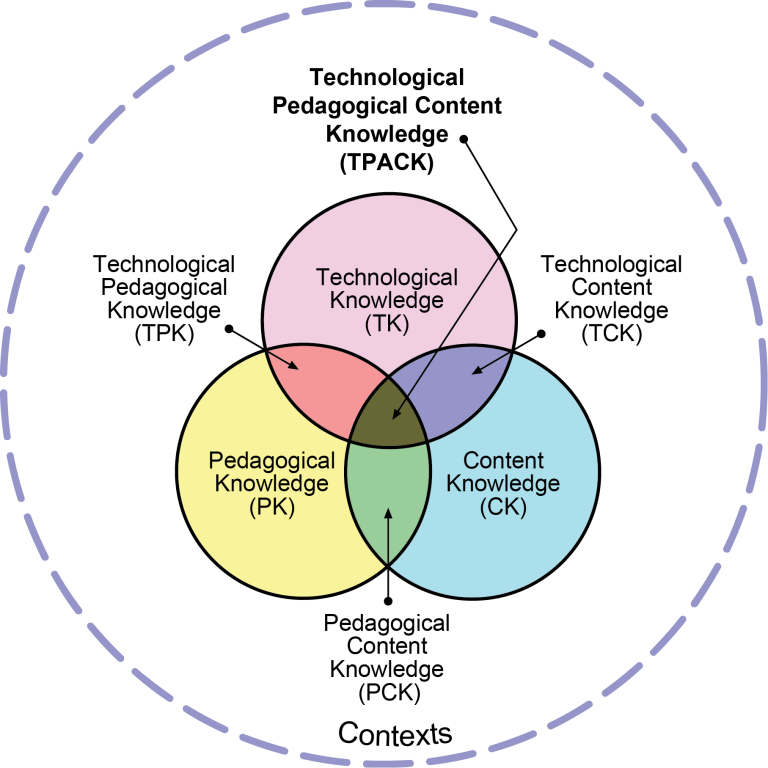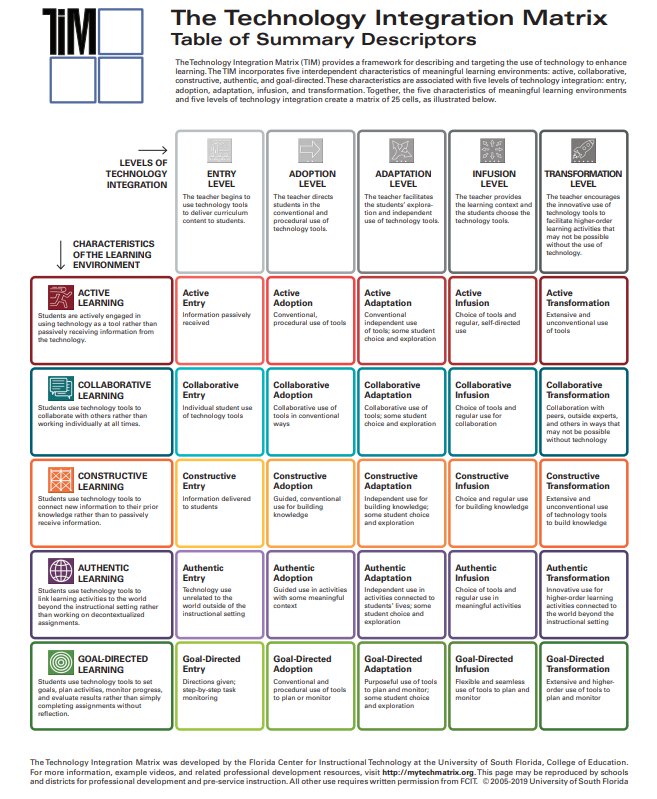Begin the "Define" section by reflecting on what you know and want to know about this "Thing."
Move beyond using technology for technology's sake. Learn to align the best practice recommendations with your own professional practice.
In this "Thing," you will explore the ISTE Standards and the most respected models for technology integration in use today.
Learning Objectives
Click on each title below to see detailed information.
As you move through "Thing" 1's playlist, you will come across many best practices and tools that will help you properly design a technology enhanced lesson. To assist you with this process, let's start with the end in mind. Think about a lesson you are currently teaching, or plan to teach in the near future.
Make a copy of the 21Things4Teachers lesson design template and fill-it in as you go along.

Select the image above to open the lesson design template. Make a Copy.
Also, we recommend that you reflect on your current practice using the Reflection Guide before you begin.
![]()
Now that you have reflected and created your copy of the lesson design template, move on to the next section - Technology Standards.
TECHNOLOGY STANDARDS
What are the standards that guide educational technology? The International Society for Technology in Education is the organization to watch. Recently celebrating 40 years in the trenches, ISTE has provided guidance in the form of standards for a variety of audiences, including:
- ISTE Standards for Educators
- ISTE Standards for Education Leaders
- ISTE Standards for Students
- ISTE Standards for Coaches
- ISTE Standards for Computer Science Educators
- And more!
The Standards are a nested model, putting students at the center as depicted in the graphic below.
Although the ISTE Standards provide guidance on what digital age teaching and learning looks like, they do not provide a prescriptive task list of basic skills for how to meet the standards.
For example, the ISTE Student Standards provide criteria on how to empower student voice and ensure a student-driven process by providing criteria to support the following 7 Standards:
- Empowered Learner
- Digital Citizen
- Knowledge Constructor
- Innovative Designer
- Computational Thinker
- Creative Communicator
- Global Collaborator
However, these standards do not have accompanying lessons. That is why many states, including Michigan, have adopted the ISTE Standards for Students to frame their student expectations AND developed programs like MITECHs in order to align them to content.
Also, ISTE provides leadership beyond the Standards, including Professional Learning Networks, professional development, online learning opportunities, an annual conference, and beyond.
One of the highest honors in Ed Tech is to be recognized by the ISTE organization. 21things4teachers and 21things4students have both earned the prestigious “Seal of Alignment” for work in ensuring that its contents meet the Standards.
For more information about ISTE and the Standards, visit https://iste.org.
STOP & THINK
Complete Section 1 of the Lesson Design Template, including the ISTE Standards.
![]()
Now that you have investigated the tech standards for education, move on to the next section - Technology Integration.
TECHNOLOGY INTEGRATION
Are you using technology for “technology sake?” How do you know?
In John Hattie’s “ Visible Learning” (2018), he updates his extensive meta-analysis on what best practice strategies have the most impact on learning. As we think about the integration of technology, it is important that we put learning first.
In 2012, Dean, Pitler, Kuhn and Ross in association with McREL released, “ Using Technology with Classroom Instruction that Works” (UTCITW). Building on what had come to be known as “The Marzano 9,” McREL took the research further and introduced technology categories. As part of the 22iTRIG project, Harding and Parker created “ TechBestPractice.net” to support the McREL research and the UTCITW framework.
When technology tools are effectively integrated into the curriculum, they can extend learning in powerful ways. These tools can provide students and teachers with:
- access to up-to-date primary source material
- methods of collecting/recording data
- ways to collaborate with students, teachers and experts around the world
- opportunities for expressing understanding via multimedia
- learning that is relevant and assessment that is authentic
- training for publishing and presenting their new knowledge
But How? In the next sections, you will explore four current models of technology integration that shape digital age teaching and learning:
- SAMR
- TPACK
- TIM
- Triple E
![]()
When you are ready, move on to the next section - SAMR.
SAMR: A Model for Technology Integration
Does the use of technology in the lesson move beyond a mere substitution for a traditional tool to the highest levels where technology redefines the learning experience? How deeply are you integrating technology to transform the learning experiences for students? The SAMR model is perhaps the most recognized model guiding technology integration, and can help you answer these questions.
SAMR, developed by Dr. Ruben Puentedura, encourages educators to deepen their application of technology in the lesson. Lessons move from the lowest levels (Substitution, then Augmentation) in the enhancement area to the highest levels (Modification, then Redefinition) in the transformation zone.
This model encourages teachers to design digital learning experiences that utilize technology to transform learning experiences to lead to higher levels of student learning.
For a video overview of SAMR from Common Sense Media, select the image below to watch/listen.
Select the image below to visit Kathy Schrock's' Guide to Everything, and more information on the SAMR Model.

Image the creation of Dr. Ruben Puentedura, Ph.D. http://www.hippasus.com/rrpweblog/ CC-BY
STOP & THINK
Complete Section 2 of the Lesson Design Template by applying the SAMR Model.
![]()
Once finished, move on to the next section - TPACK.
TPACK: A Model for Technology Integration
Technological Pedagogical Content Knowledge (TPACK ) is a framework that identifies the knowledge teachers need to teach effectively with technology. The TPACK framework extends Lee Shulman’s idea of Pedagogical Content Knowledge (PCK). Punya Mishar and Matthew J. Koehler, professors at Michigan State University, are credited with extensive work in constructing the TPACK framework.
The following are the components of TPACK:
- Pedagogical Content Knowledge (PCK) — understanding the best practices for teaching specific content to your specific students.
- Technological Content Knowledge (TCK) — knowing how the digital tools available to you can enhance or transform the content, how it’s delivered to students, and how your students can interact with it.
- Technological Pedagogical Knowledge (TPK) — understanding how to use your digital tools as a vehicle to the learning outcomes and experiences you want.
To get started, select the image below to view/listen to “TPACK in 2 Minutes.”
"TPACK ... attempts to capture some of the essential qualities of knowledge required by teachers for technology integration in their teaching, while addressing the complex, multifaceted and situated nature of teacher knowledge. At the heart of the TPACK framework, is the complex interplay of three primary forms of knowledge: Content (CK), Pedagogy (PK), and Technology (TK)." Source: Punya Mishra's' Web, April 7, 2014.
TPACK differs from SAMR in its addition of the content and pedagogy elements. While SAMR encourages educators to deepen the level of technology application, the TPACK model adds an emphasis on knowing your content and applying best practice.

TPACK image reproduced by permission of the publisher, © 2012 by tpack.org
STOP & THINK
Complete section 3 of the Lesson Design Template by applying the TPACK Model.
![]()
Once finished, move on to the next section - Technology Integration Matrix (TIM).
TIM: A Model for Technology Integration
The Technology Integration Matrix (TIM) provides a framework for describing and targeting the use of technology to enhance learning.
The TIM incorporates five interdependent characteristics of meaningful learning environments: active, collaborative, constructive, authentic, and goal-directed.
These characteristics are associated with five levels of technology integration: entry, adoption, adaptation, infusion, and transformation.
Together, the five characteristics of meaningful learning environments and five levels of technology integration create a matrix of 25 cells, as illustrated below. Developed by the Florida Center for Instructional Technology (FCIT) in 2005, the TIM is now in its third edition (2019).

Select this link for a printer-friendly version of the TIM Descriptor Table.
STOP & THINK
Complete section 4 of the Lesson Design Template by applying the Technology Integration Matrix (TIM).
![]()
Once finished, move on to the next section - Triple E.
TRIPLE E: A Model for Technology Integration
How well are the technology tools you choose improving student engagement, enhancing instruction, or extending the learning? The Triple E Framework, developed by Dr. Liz Kolb of the University of Michigan, provides a way to evaluate similar technology tools to use in your classroom and answer these questions.
Explore this video for an overview on “The Triple E Framework Explained.” Select the video below to view/listen.
One of the points to ponder with Triple E is the emphasis on best practice. Given the strategies below, think about what types of technology you could use in your lessons to engage, enhance, or extend the learning?

Select the image above to be taken to the source.
Visit the Triple E Framework home page and use the rubric to evaluate apps and websites to improve lessons that extend, enhance, and engage.
STOP & THINK
Complete section 5 of the Lesson Design Template by applying the Triple E Framework.
This is the last section of "Thing" 1's Define playlist. Now would be a great time to revisit your Reflection Document and think about what you learned in this "Thing." Capture a screenshot of your results from the Knowledge Check and post them in your Reflection Document. As you move forward, consider the following: How might you use this in your own professional practice? What goals might you set for yourself, including activities, timelines, and evaluation? What connections did you make to the ISTE Standards or your own content area standards? How will you monitor your own progress towards these goals? Then proceed to the next section.